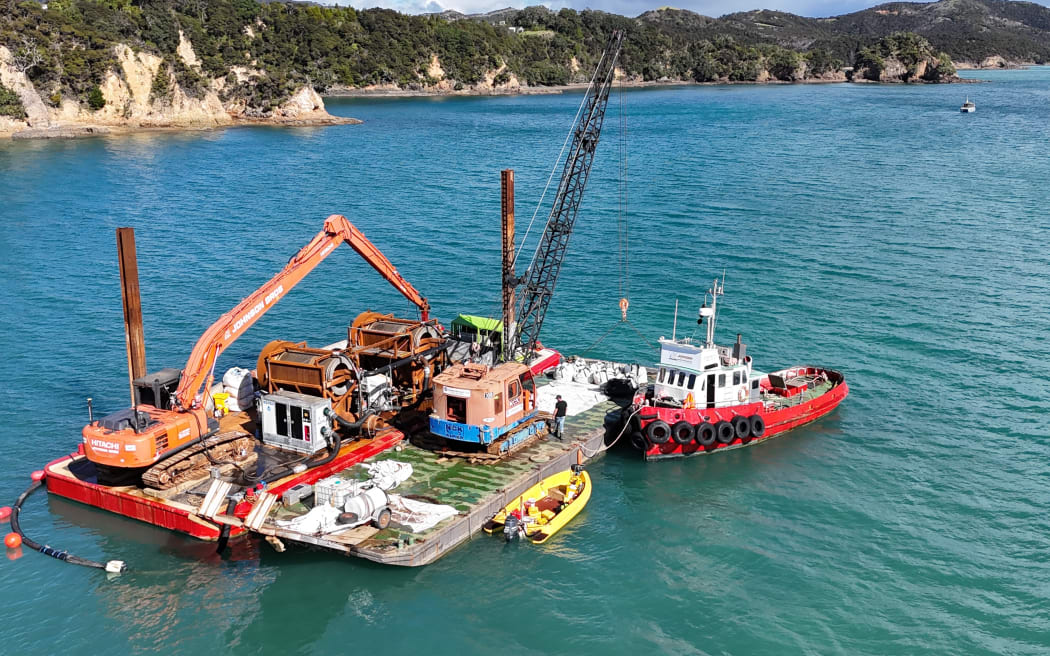- Dredging Caulerpa: A Critical Biosecurity Battle
- Challenges in Dredging Caulerpa
- Caulerpa Infestation in Omākiwi Cove
- Innovative Solutions for Efficient Dredging
- Government Funding and Future Plans
- Biosecurity Review and Long-term Goals
- Aiming for Complete Eradication
- Enhanced Marine Biosecurity Efforts
- Ensuring No Caulerpa Fragment Reintroduction
- Recognizing Key Contributors
- Collaborative Efforts in Bay of Islands
- Conclusion: The Need for Continued Support
Dredging Caulerpa: A Critical Biosecurity Battle
The completion of a dredging operation targeting a highly invasive seaweed in the Bay of Islands hinges on an additional $5 million in government funding, according to a Northland council leader. The exotic seaweed, caulerpa, renowned for its ability to smother other marine life, has been found in Aotea Great Barrier Island, the Bay of Islands, and the Hauraki Gulf. However, intensive eradication efforts are currently focused solely on the Bay of Islands.
Challenges in Dredging Caulerpa
Earlier this year, the eradication project faced delays when the custom-built suction dredge began extracting excessive amounts of sand along with the seaweed, significantly slowing down operations. Geoff Crawford, chairman of the Northland Regional Council, reported that a recent redesign of the dredge has dramatically improved efficiency, enabling the machine to clear half a hectare of seabed per day, with the goal of increasing this rate to a hectare daily.
Caulerpa Infestation in Omākiwi Cove
Approximately 60 hectares in Omākiwi Cove, near Rāwhiti in the eastern Bay of Islands, are infested with caulerpa. The initial dredge design encountered issues as it filled the barge’s 100-tonne dewatering bag within an hour, leading to a delay of up to two days for unloading, depending on tidal conditions. A significant breakthrough came from Russell marine engineer Andrew Johnson, who adapted gold-mining trommels—rotating cylinders with mesh screens—to separate sand from seaweed fragments. This innovation allows sand to be returned to the seabed while caulerpa is collected in one-tonne bags, enabling continuous operation for up to eight hours a day.
Innovative Solutions for Efficient Dredging
Crawford highlighted the success of this approach, attributing it to Johnson’s resourceful thinking. He expressed optimism that dredging in the Bay of Islands could be completed by August, describing this progress as a major achievement for Northland. The dredge might then be deployed to Aotea Great Barrier Island next.
Government Funding and Future Plans
In February, the government allocated $5 million to caulerpa projects across the upper North Island, with $3.3 million designated for the Bay of Islands dredging trial. However, this funding is set to expire on June 30, prompting a request for an additional $5-6 million to complete the task at Omākiwi Cove. Crawford emphasized the urgency, noting the relatively low cost compared to the significant threat posed by caulerpa.
Biosecurity Review and Long-term Goals
Biosecurity Minister Andrew Hoggard stated that Biosecurity New Zealand would review the trial data in late June or early July and provide recommendations accordingly. Crawford stressed the importance of developing a machine capable of operating 24 hours a day without the need for unloading to maximize efficiency, likening the urgency to combating cancer due to caulerpa’s rapid spread.
Aiming for Complete Eradication
The regional council’s ultimate goal is complete eradication, with the current dredging operation being only the initial phase. A minimum 10-year surveillance and maintenance period will be required to prevent reinvasion. Without a long-term commitment, Crawford argued, initial efforts and spending would be futile.
Enhanced Marine Biosecurity Efforts
Regional council marine biosecurity specialist Kaeden Leonard expressed his encouragement with the trial results, noting the significant scaling up of capabilities to tackle marine pests. The innovative approach has greatly enhanced marine biosecurity efforts, moving from diver-assisted tools to a more mechanical, efficient process.
Ensuring No Caulerpa Fragment Reintroduction
The dredge now efficiently removes caulerpa while returning sand and silt to the seabed. Independent scientists regularly inspect dredge spoil to ensure no viable caulerpa fragments are reintroduced to the bay. While the dredge is effective in most areas, other methods, such as hand-held suction devices and light-deprivation mats, may be needed in rocky regions.
Recognizing Key Contributors
Additionally, Viki Heta and Rana Rewha, a Far North couple pivotal in the caulerpa battle, recently received the country’s top biosecurity award for their efforts. Rewha discovered caulerpa in the Bay of Islands in May 2023, and both he and Heta have played crucial roles in the response.
Collaborative Efforts in Bay of Islands
The Bay of Islands trial involves various stakeholders, including local hapū, the Northland Regional Council, Ministry for Primary Industries, the Cawthron Institute, community group Conquer Caulerpa, and maritime engineering firm Johnson Bros. Removed caulerpa is buried nearby due to biosecurity regulations prohibiting its transport out of the affected area.
Conclusion: The Need for Continued Support
To secure the Bay of Islands against the invasive caulerpa, sustained funding and innovative solutions are essential. The concerted efforts of the regional council, local engineers, and community members showcase the potential for success with adequate resources and support.
